名词性物主代词和形容词性物主代词的用法培训讲学
- 格式:doc
- 大小:22.50 KB
- 文档页数:6
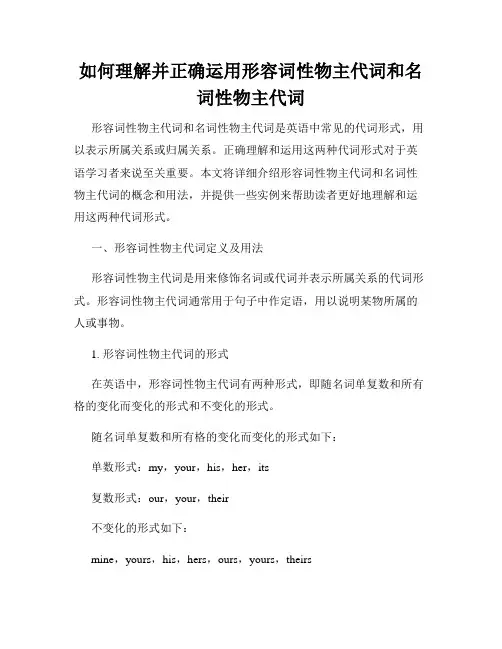
如何理解并正确运用形容词性物主代词和名词性物主代词形容词性物主代词和名词性物主代词是英语中常见的代词形式,用以表示所属关系或归属关系。
正确理解和运用这两种代词形式对于英语学习者来说至关重要。
本文将详细介绍形容词性物主代词和名词性物主代词的概念和用法,并提供一些实例来帮助读者更好地理解和运用这两种代词形式。
一、形容词性物主代词定义及用法形容词性物主代词是用来修饰名词或代词并表示所属关系的代词形式。
形容词性物主代词通常用于句子中作定语,用以说明某物所属的人或事物。
1. 形容词性物主代词的形式在英语中,形容词性物主代词有两种形式,即随名词单复数和所有格的变化而变化的形式和不变化的形式。
随名词单复数和所有格的变化而变化的形式如下:单数形式:my,your,his,her,its复数形式:our,your,their不变化的形式如下:mine,yours,his,hers,ours,yours,theirs2. 形容词性物主代词的用法形容词性物主代词通常在句子中作为定语修饰名词或代词,表示所属关系。
例如:- This is my book.(这是我的书。
)- Is this your car?(这是你的车吗?)- His mother is a doctor.(他的妈妈是医生。
)二、名词性物主代词定义及用法名词性物主代词是用来代替名词并表示所属关系的代词形式。
名词性物主代词通常用于句子中作主语、宾语或表语,用以代替某物所属的人或事物。
1. 名词性物主代词的形式在英语中,名词性物主代词的形式只有一种,即随名词单复数的变化而变化的形式。
随名词单复数的变化而变化的形式如下:单数形式:mine,yours,his,hers,its复数形式:ours,yours,theirs2. 名词性物主代词的用法名词性物主代词通常在句子中作为主语、宾语或表语,表示所属关系。
例如:- The red pen is mine.(那支红笔是我的。
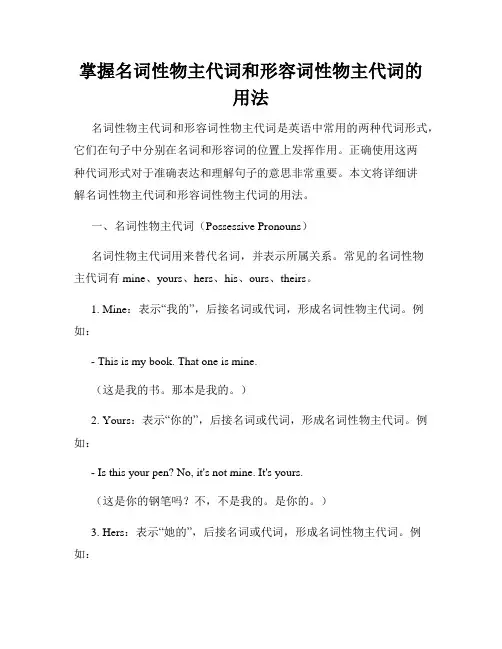
掌握名词性物主代词和形容词性物主代词的用法名词性物主代词和形容词性物主代词是英语中常用的两种代词形式,它们在句子中分别在名词和形容词的位置上发挥作用。
正确使用这两种代词形式对于准确表达和理解句子的意思非常重要。
本文将详细讲解名词性物主代词和形容词性物主代词的用法。
一、名词性物主代词(Possessive Pronouns)名词性物主代词用来替代名词,并表示所属关系。
常见的名词性物主代词有mine、yours、hers、his、ours、theirs。
1. Mine:表示“我的”,后接名词或代词,形成名词性物主代词。
例如:- This is my book. That one is mine.(这是我的书。
那本是我的。
)2. Yours:表示“你的”,后接名词或代词,形成名词性物主代词。
例如:- Is this your pen? No, it's not mine. It's yours.(这是你的钢笔吗?不,不是我的。
是你的。
)3. Hers:表示“她的”,后接名词或代词,形成名词性物主代词。
例如:- Whose bag is this? It's not mine or yours, it must be hers.(这是谁的包?不是我的也不是你的,肯定是她的。
)4. His:表示“他的”,后接名词或代词,形成名词性物主代词。
例如:- Is that his car? Yes, it's his.(那是他的车吗?是的,是他的。
)5. Ours:表示“我们的”,后接名词或代词,形成名词性物主代词。
例如:- Whose house is this? It's not theirs, it's ours.(这是谁的房子?不是他们的,是我们的。
)6. Theirs:表示“他们的”,后接名词或代词,形成名词性物主代词。
例如:- Whose bikes are those? They're not ours, they must be theirs.(那些自行车是谁的?不是我们的,肯定是他们的。


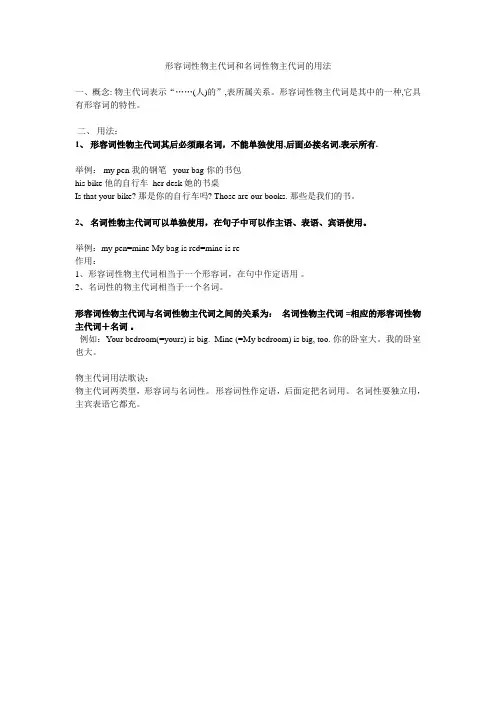
形容词性物主代词和名词性物主代词的用法一、概念: 物主代词表示“……(人)的”,表所属关系。
形容词性物主代词是其中的一种,它具有形容词的特性。
二、用法:1、形容词性物主代词其后必须跟名词,不能单独使用,后面必接名词,表示所有.举例: my pen我的钢笔 your bag你的书包his bike他的自行车 her desk她的书桌Is that your bike? 那是你的自行车吗? Those are our books. 那些是我们的书。
2、名词性物主代词可以单独使用,在句子中可以作主语、表语、宾语使用。
举例:my pen=mine My bag is red=mine is re作用:1、形容词性物主代词相当于一个形容词,在句中作定语用。
2、名词性的物主代词相当于一个名词。
形容词性物主代词与名词性物主代词之间的关系为:名词性物主代词 =相应的形容词性物主代词+名词。
例如:Your bedroom(=yours) is big. Mine (=My bedroom) is big, too. 你的卧室大。
我的卧室也大。
物主代词用法歌诀:物主代词两类型,形容词与名词性。
形容词性作定语,后面定把名词用。
名词性要独立用,主宾表语它都充。
形容词性物主代词和名词性物主代词讲解及练习物主代词表示“……(人)的”,表所属关系。
形容词性物主代词是其中的一种,它具有形容词的特性。
形容词性物主代词有:my, your, his, her, its, our(我们的), your(你们的),their(他们的)。
用法点击:◆形容词性物主代词其后必须跟名词。
如: 形容词性物主代词不能单独使用,后面必接名词,表示所有.如:my pen我的钢笔 your bag你的书包his bike他的自行车 her desk她的书桌its name它的名字Is that your bike? 那是你的自行车吗?Those are our books. 那些是我们的书。

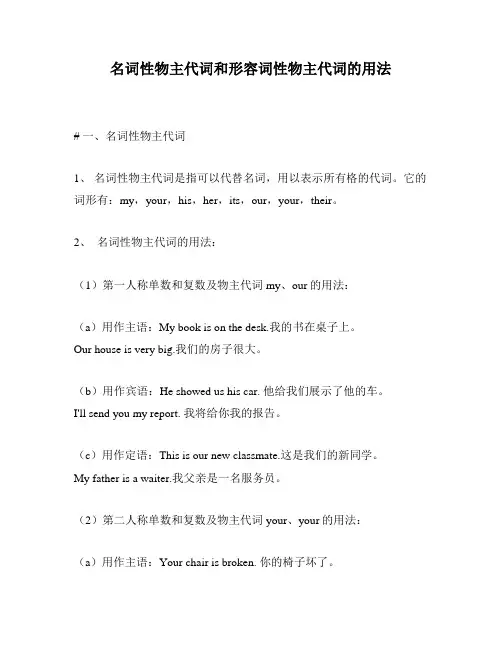
名词性物主代词和形容词性物主代词的用法# 一、名词性物主代词1、名词性物主代词是指可以代替名词,用以表示所有格的代词。
它的词形有:my,your,his,her,its,our,your,their。
2、名词性物主代词的用法:(1)第一人称单数和复数及物主代词my、our的用法:(a)用作主语:My book is on the desk.我的书在桌子上。
Our house is very big.我们的房子很大。
(b)用作宾语:He showed us his car. 他给我们展示了他的车。
I'll send you my report. 我将给你我的报告。
(c)用作定语:This is our new classmate.这是我们的新同学。
My father is a waiter.我父亲是一名服务员。
(2)第二人称单数和复数及物主代词your、your的用法:(a)用作主语:Your chair is broken. 你的椅子坏了。
Your cat is very cute. 你的猫很可爱。
(b)用作宾语:He brought you your bag. 他给你带来了你的背包。
I'll do your homework. 我会做你的作业。
(c)用作定语:This is your desk.这是你的桌子。
Your homework is done. 你的作业已经做完了。
(3)第三人称单数和复数及物主代词his、hers、its、theirs的用法:(a)用作主语:His book is on the desk. 他的书在桌子上。
Their school is very big. 他们的学校很大。
(b)用作宾语:He showed her his car.他给她展示了他的车。
I'll give it back to them. 我会把它还给他们。
(c)用作定语:This is his new classmate.这是他的新同学。
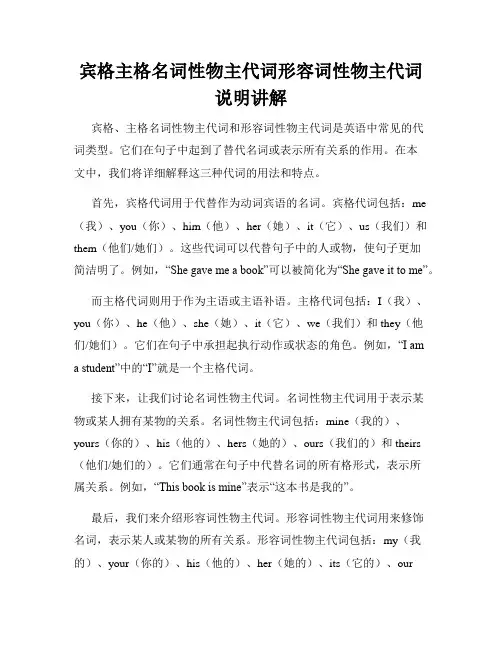
宾格主格名词性物主代词形容词性物主代词说明讲解宾格、主格名词性物主代词和形容词性物主代词是英语中常见的代词类型。
它们在句子中起到了替代名词或表示所有关系的作用。
在本文中,我们将详细解释这三种代词的用法和特点。
首先,宾格代词用于代替作为动词宾语的名词。
宾格代词包括:me (我)、you(你)、him(他)、her(她)、it(它)、us(我们)和them(他们/她们)。
这些代词可以代替句子中的人或物,使句子更加简洁明了。
例如,“She gave me a book”可以被简化为“She gave it to me”。
而主格代词则用于作为主语或主语补语。
主格代词包括:I(我)、you(你)、he(他)、she(她)、it(它)、we(我们)和they(他们/她们)。
它们在句子中承担起执行动作或状态的角色。
例如,“I ama student”中的“I”就是一个主格代词。
接下来,让我们讨论名词性物主代词。
名词性物主代词用于表示某物或某人拥有某物的关系。
名词性物主代词包括:mine(我的)、yours(你的)、his(他的)、hers(她的)、ours(我们的)和theirs (他们/她们的)。
它们通常在句子中代替名词的所有格形式,表示所属关系。
例如,“This book is mine”表示“这本书是我的”。
最后,我们来介绍形容词性物主代词。
形容词性物主代词用来修饰名词,表示某人或某物的所有关系。
形容词性物主代词包括:my(我的)、your(你的)、his(他的)、her(她的)、its(它的)、our(我们的)和their(他们/她们的)。
这些代词用来描述名词的特征或属性。
例如,“His car is red”表示“他的车是红色的”。
总的来说,宾格代词、主格代词、名词性物主代词和形容词性物主代词在英语中扮演着重要的角色。
它们不仅可以使句子更加简洁明了,还能准确表达人与物之间的关系。
熟练掌握这些代词的用法和特点,对于提高英语的表达能力和理解能力都非常有帮助。
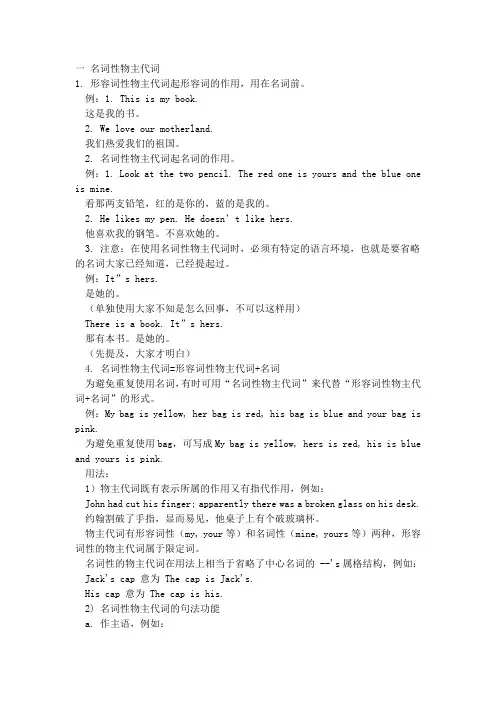
一名词性物主代词1. 形容词性物主代词起形容词的作用,用在名词前。
例:1. This is my book.这是我的书。
2. We love our motherland.我们热爱我们的祖国。
2. 名词性物主代词起名词的作用。
例:1. Look at the two pencil. The red one is yours and the blue one is mine.看那两支铅笔,红的是你的,蓝的是我的。
2. He likes my pen. He doesn’t like hers.他喜欢我的钢笔。
不喜欢她的。
3. 注意:在使用名词性物主代词时,必须有特定的语言环境,也就是要省略的名词大家已经知道,已经提起过。
例:It”s hers.是她的。
(单独使用大家不知是怎么回事,不可以这样用)There is a book. It”s hers.那有本书。
是她的。
(先提及,大家才明白)4. 名词性物主代词=形容词性物主代词+名词为避免重复使用名词,有时可用“名词性物主代词”来代替“形容词性物主代词+名词”的形式。
例:My bag is yellow, her bag is red, his bag is blue and your bag is pink.为避免重复使用bag,可写成My bag is yellow, hers is red, his is blue and yours is pink.用法:1)物主代词既有表示所属的作用又有指代作用,例如:John had cut his finger; apparently there was a broken glass on his desk. 约翰割破了手指,显而易见,他桌子上有个破玻璃杯。
物主代词有形容词性(my, your等)和名词性(mine, yours等)两种,形容词性的物主代词属于限定词。
名词性的物主代词在用法上相当于省略了中心名词的 --'s属格结构,例如: Jack's cap 意为 The cap is Jack's.His cap 意为 The cap is his.2) 名词性物主代词的句法功能a. 作主语,例如:May I use your pen? Yours works better.我可以用一用你的钢笔吗?你的比我的好用。
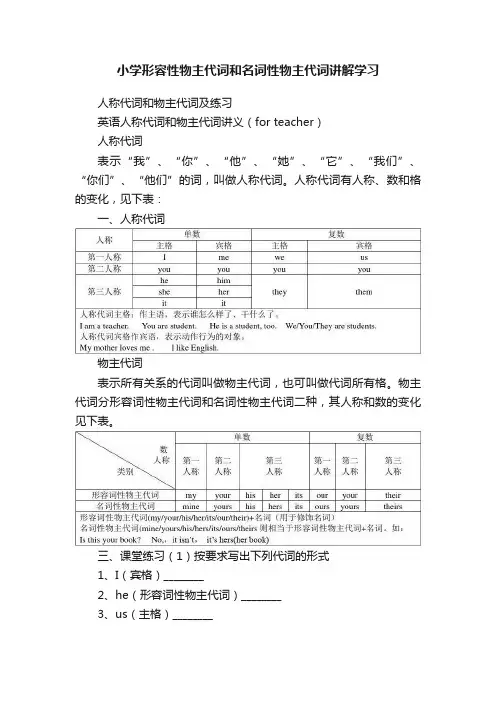
小学形容性物主代词和名词性物主代词讲解学习人称代词和物主代词及练习英语人称代词和物主代词讲义(for teacher)人称代词表示“我”、“你”、“他”、“她”、“它”、“我们”、“你们”、“他们”的词,叫做人称代词。
人称代词有人称、数和格的变化,见下表:一、人称代词物主代词表示所有关系的代词叫做物主代词,也可叫做代词所有格。
物主代词分形容词性物主代词和名词性物主代词二种,其人称和数的变化见下表。
三、课堂练习(1)按要求写出下列代词的形式1、I(宾格)________2、he(形容词性物主代词)________3、us(主格)________4、they(宾格)________5、she(宾格)________6、you(名词性物主代词)________7、it(宾格)________8、him(复数)________9、her(形容词性物主代词)________10、my(复数)________11、they(名词性物主代词)________12、we(单数)________(2)选出括号中正确的词,在正确的词上打勾。
1. This is(my / I)mother.2. Nice to meet (your / you).3.(He / His)name is Mark.4. What’s(she / her)name?5. Excuse(me / my / I).6. Are(your / you)Miss Li?7.(I/ My)am Ben.8.(She / Her)is my sister.9. Fine , thank(your / you).10. How old is (he / his)?(3)用所给代词的正确形式填空。
1. These are ______ ( he ) brothers.2. That is _______( she ) sister.3. Lily is _______ ( Lucy ) sister.4. Tom, this is _____ ( me ) cousin, Mary.5. Now _____________(her parent) are in America.6. Those __________ ( child ) are _____ ( I ) father’s students.7. Do you know ______ ( it ) name?8. Mike and T om __________ ( be ) friends.9. Thanks for helping ________( I ).10. ______(Ann安)mother is ______(we) teacher.(4)填上正确的人称代词和物主代词1._____ is my friend. 他是我的朋友。
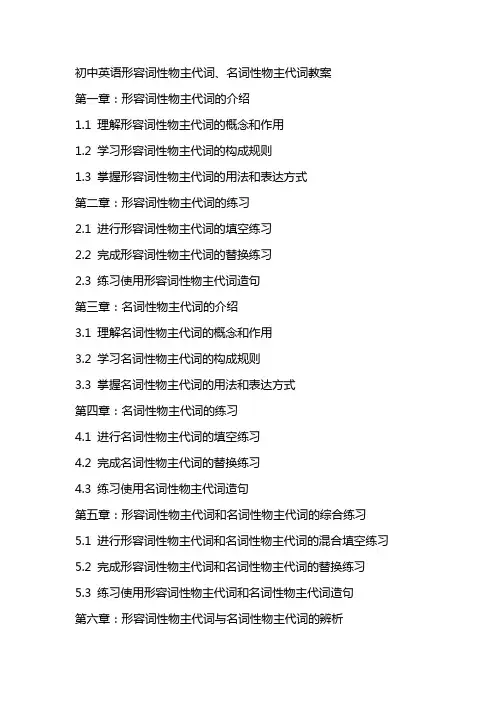
初中英语形容词性物主代词、名词性物主代词教案第一章:形容词性物主代词的介绍1.1 理解形容词性物主代词的概念和作用1.2 学习形容词性物主代词的构成规则1.3 掌握形容词性物主代词的用法和表达方式第二章:形容词性物主代词的练习2.1 进行形容词性物主代词的填空练习2.2 完成形容词性物主代词的替换练习2.3 练习使用形容词性物主代词造句第三章:名词性物主代词的介绍3.1 理解名词性物主代词的概念和作用3.2 学习名词性物主代词的构成规则3.3 掌握名词性物主代词的用法和表达方式第四章:名词性物主代词的练习4.1 进行名词性物主代词的填空练习4.2 完成名词性物主代词的替换练习4.3 练习使用名词性物主代词造句第五章:形容词性物主代词和名词性物主代词的综合练习5.1 进行形容词性物主代词和名词性物主代词的混合填空练习5.2 完成形容词性物主代词和名词性物主代词的替换练习5.3 练习使用形容词性物主代词和名词性物主代词造句第六章:形容词性物主代词与名词性物主代词的辨析6.1 学习形容词性物主代词和名词性物主代词的差异6.2 练习区分和使用形容词性物主代词和名词性物主代词6.3 讨论形容词性物主代词和名词性物主代词在实际语境中的应用第七章:物主代词的句型结构7.1 学习使用物主代词的常见句型结构7.2 练习构成含有物主代词的句子7.3 分析并改正句型结构使用错误的例句第八章:物主代词在日常生活对话中的应用8.1 学习物主代词在日常对话中的用法8.2 模拟日常生活对话,练习使用物主代词8.3 分析日常对话中物主代词使用的正确与错误第九章:物主代词在写作中的运用9.1 学习物主代词在写作中的重要性和作用9.2 练习在写作中正确使用物主代词9.3 分析写作中物主代词使用不当的例文并修改第十章:物主代词的复习与测试10.1 复习形容词性物主代词和名词性物主代词的主要用法10.2 完成物主代词的综合练习题10.3 进行物主代词的知识点测试,评估学习效果第十一章:物主代词在特定情境中的运用11.1 学习物主代词在特定情境中的表达方式11.2 练习在不同的情境中正确使用物主代词11.3 讨论物主代词在不同情境中的语义差异第十二章:物主代词的扩展学习12.1 学习与物主代词相关的扩展词汇和短语12.2 练习使用扩展词汇和短语,增强语言表达12.3 分析并改正扩展词汇和短语使用错误的例句第十三章:物主代词的跨文化交际应用13.1 了解物主代词在不同文化背景中的用法差异13.2 学习如何在跨文化交际中正确使用物主代词13.3 模拟跨文化交际场景,练习使用物主代词第十四章:物主代词的教学活动设计14.1 设计旨在巩固物主代词知识的教学活动14.2 实施教学活动,收集学生反馈14.3 评估教学活动的效果,进行必要的调整第十五章:物主代词的学习评估与总结15.1 通过测试和练习评估学生对物主代词的掌握程度15.2 分析学生的学习成果,总结教学经验15.3 提出改进教学策略的建议,为今后的教学提供参考重点和难点解析本文主要介绍了形容词性物主代词和名词性物主代词的用法、辨析、句型结构、日常生活应用、写作运用以及跨文化交际等方面的知识。
形容词性物主代词和名词性物主代词的用法一、概念:物主代词表示“……(人)的”,表所属关系。
形容词性物主代词是其中的一种,它具有形容词的特征。
二、物主代词用法歌诀。
物主代词两类型,形容词与名词性。
形容词性作定语,后面定把名词用。
名词性要独立用,主宾表语它都充。
①人称代词的主格在句子中作主语1. I am sorry I am late.2. They/We are both from the south.3.She is clever than me.②.人称代词的宾格在句子中作动词宾语或介词宾语,表语。
1.His mother told him to study hard.2.Deming’s mother bought a new bike for him.3.Who is it ? It is me③.形容词性物主代词一般位于名词前,用作定语。
1 .My name is John Green. 我叫约翰?格林。
2.Excuse me, is this your car? 对不起,这是您的车吗?3. His parents are in England. 他的父母在英国。
4.They wash their faces every day. 他们每天都洗脸。
④.名词性物主代词的句法功能a. 作主语,例如:May I use your pen? Yours works better.我可以用一用你的钢笔吗?b. 作宾语,例如:I love my motherland as much as you love yours.我爱我的祖国就像你爱你的祖国一样深。
c. 作介词宾语,例如:Your should interpret what I said in my sense of the word, not in yours.你应当按我所用的词义去解释我说的话,而不能按你自己的意义去解释。
d. 作表语,例如:Is this your book or mine?e. 名词性物主代词=形容词性物主代词+名词为避免重复使用名词,有时可用“名词性物主代词”来代替“形容词性物主代词+名词”的形式。
名词性物主代词和形容词性物主代词的用
法
形容词性物主代词与名词性物主代词的用法
一.人称代词的主格在句子中作主语
1. I am sorry I am late.
2. They/We are both from the south.
3.She is clever than me.
二.人称代词的宾格在句子中作动词宾语或介词宾语,表语。
1His mother told him to study hard.
2Deming’s mother bought a new bike for him.
3.Who is it ? It is me
三.形容词性物主代词一般位于名词前,用作定语。
1My name is John Green.我叫约翰·格林。
2Excuse me, is this your car?对不起,这是您的车吗?
3His parents are in England.他的父母在英国。
4They wash their faces every day.他们每天都洗脸。
四.名词性物主代词的句法功能
a.作主语,例如:
May I use your pen? Yours works better.
我可以用一用你的钢笔吗?
b.作宾语,例如:
成都戴氏教育金堂分校
I love my motherland as much as you love yours.
我爱我的祖国就像你爱你的祖国一样深。
c.作介词宾语,例如:
Your should interpret what I said in my sense of the word, not in yours.
你应当按我所用的词义去解释我说的话,而不能按你自己的意义去解释。
d.作表语,例如:
Is this your book or mine?
e.名词性物主代词=形容词性物主代词+名词
为避免重复使用名词,有时可用“名词性物主代词”来代替“形容词性物主
代词+名词”的形式。
例:My bag is yellow, her bag is red, his bag is blue and your bag is pink.
为避免重复使用bag,可写成My bag is yellow, hers is red, his is blue and
. yours is pin
f.名词性物主代词有时可以和of构成短语,
1A friend of mine is good at English.
2I hate that behaviour (行为)of hers
That photo of yours is beautiul.
成都戴氏教育金堂分校形容词性物主代词与名词性物主代词的练习
一.用所给词的适当形式填空
1. That is not _________ kite. That kite is very small, but _________ is very big. ( I )
2. The dress is _________. Give it to _________. ( she )
3. Is this _________ watch? (you) No, it’s not _________ . ( I )
4. _________ is my brother. _________ name is Jack.
Look! Those stamps are _________. ( he )
5. _________ dresses are red. (we) What colour are _________? ( you )
6. Here are many dolls, which one is _________ ? ( she )
7. I can find my toy, but where’s _________? ( you )
8. Show _________ your kite, OK? (they)
9. I have a beautiful cat. _________name is Mimi.
These cakes are _________. ( it )
10. Are these _________ tickets?
No, _________ are not _________. _________ aren’t here. ( they ) 11. Shall _________ have a look at that classroom? That is _________ classroom. ( we )
12. _________ is my aunt. Do you know _________ job?
_________ a nurse. ( she )
13. That is not _________ camera. _________is at home. ( he )
14. Where are _________? I can’t find _________.
Let’s call _________ parents. ( they )
15. Don’t touch _________. _________ not a cat, _________ a tiger!(it)
16. _________ sister is ill. Please go and get _________. ( she )
17. _________ don’t know her name.
Would you please tell _________. ( we )
18. So many dogs. Let’s count _________. ( they )
19. I have a lovely brother. _________ is only 3.
I like _________ very much. ( he )
20. May I sit beside _________? ( you )
21. Look at that desk. Those book are on _________. ( it )
22.The girl behind _________ is our friend. (she )
成都戴氏教育金堂分校
二、用am, is, are 填空
1. I ______ a boy. ______ you a boy? No, I _____ not.
2. The girl______ Jack's sister.
3. The dog _______ tall and fat.
4. The man with big eyes _______ a teacher.
5. ______ your brother in the classroom?
6. Where _____ your mother? She ______ at home.
7. How _______ your father?
8. Mike and Liu Tao ______ at school.
9. Whose dress ______ this?
10. Whose socks ______ they?
11. That ______ my red skirt.
12. Who ______ I?
13.The jeans ______ on the desk.
14.Here ______ a scarf for you.
15. Here ______ some sweaters for you.
16. The black gloves ______ for Su Yang.
17. This pair of gloves ______ for Yang Ling.
18. The two cups of milk _____ for me.
19. Some tea ______ in the glass.
20. Gao shan's shirt _______ over there.
21. My sister's name ______Nancy.
22. This ______ not Wang Fang's pencil.
23. ______ David and Helen from England?
24. There ______ a girl in the room.
25. There ______ some apples on the tree.
26. _______ there any kites in the classroom?
27. _______ there any apple juice in the bottle?
28. There _______ some bread on the plate.
29. There _______ a boy, two girls, three men and ten women in the park.
30. You, he and I ______ from China.。